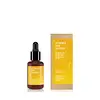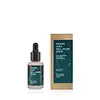What's inside
What's inside
 Key Ingredients
Key Ingredients

 Benefits
Benefits

 Concerns
Concerns

 Ingredients Side-by-side
Ingredients Side-by-side

Water
Skin ConditioningPropanediol
SolventGlycerin
HumectantAcacia Senegal Gum
MaskingLithops Pseudotruncatella Callus Lysate
Skin ConditioningCichorium Intybus Root Extract
MaskingSaccharomyces/Grape Ferment Extract
Skin ConditioningZea Mays Oil
EmulsifyingDaucus Carota Sativa Root Extract
Skin ConditioningCyamopsis Tetragonoloba Gum
Emulsion StabilisingPentylene Glycol
Skin ConditioningHelianthus Annuus Seed Oil
EmollientXanthan Gum
EmulsifyingLactic Acid
BufferingSodium Citrate
BufferingSodium Phytate
1,2-Hexanediol
Skin ConditioningCaprylyl Glycol
EmollientPhytic Acid
Ascorbyl Palmitate
AntioxidantPotassium Sorbate
PreservativeSodium Benzoate
MaskingWater, Propanediol, Glycerin, Acacia Senegal Gum, Lithops Pseudotruncatella Callus Lysate, Cichorium Intybus Root Extract, Saccharomyces/Grape Ferment Extract, Zea Mays Oil, Daucus Carota Sativa Root Extract, Cyamopsis Tetragonoloba Gum, Pentylene Glycol, Helianthus Annuus Seed Oil, Xanthan Gum, Lactic Acid, Sodium Citrate, Sodium Phytate, 1,2-Hexanediol, Caprylyl Glycol, Phytic Acid, Ascorbyl Palmitate, Potassium Sorbate, Sodium Benzoate
Water
Skin ConditioningGlycerin
HumectantPentylene Glycol
Skin ConditioningGlyceryl Oleate Citrate
EmulsifyingC13-15 Alkane
SolventXylitylglucoside
HumectantBakuchiol
AntimicrobialCoco-Caprylate/Caprate
EmollientPropanediol
SolventHeptyl Undecylenate
EmollientAnhydroxylitol
HumectantCetyl Alcohol
EmollientArginine
MaskingBehenyl Alcohol
EmollientGlyceryl Behenate
EmollientMaltodextrin
AbsorbentCaprylic/Capric Triglyceride
MaskingParfum
MaskingRibose
HumectantLevulinic Acid
PerfumingXylitol
HumectantLecithin
EmollientMannitol
HumectantPersea Gratissima Fruit Extract
EmollientXanthan Gum
EmulsifyingPhosphatidylcholine
EmulsifyingSodium Gluconate
Skin ConditioningHelianthus Annuus Seed Oil
EmollientSodium Levulinate
Skin ConditioningXanthophylls
Skin ConditioningLansium Domesticum Leaf Extract
Skin ConditioningTrehalose
HumectantHyaluronic Acid
HumectantCaesalpinia Spinosa Gum
Skin ConditioningP-Anisic Acid
MaskingPotassium Sorbate
PreservativeSodium Benzoate
MaskingAnigozanthos Flavidus Extract
Skin ConditioningHydrolyzed Pinus Sibirica Seedcake Extract
Skin ConditioningGlucose
HumectantDecyl Glucoside
CleansingTocopherol
AntioxidantAscorbyl Palmitate
AntioxidantHydrolyzed Rhodophyceae Extract
Acanthopanax Senticosus Root Extract
Skin ConditioningTricholoma Matsutake Extract
Skin ConditioningSodium Chloride
MaskingCitric Acid
BufferingHydrolyzed Hyaluronic Acid
HumectantNarcissus Tazetta Bulb Extract
AstringentWater, Glycerin, Pentylene Glycol, Glyceryl Oleate Citrate, C13-15 Alkane, Xylitylglucoside, Bakuchiol, Coco-Caprylate/Caprate, Propanediol, Heptyl Undecylenate, Anhydroxylitol, Cetyl Alcohol, Arginine, Behenyl Alcohol, Glyceryl Behenate, Maltodextrin, Caprylic/Capric Triglyceride, Parfum, Ribose, Levulinic Acid, Xylitol, Lecithin, Mannitol, Persea Gratissima Fruit Extract, Xanthan Gum, Phosphatidylcholine, Sodium Gluconate, Helianthus Annuus Seed Oil, Sodium Levulinate, Xanthophylls, Lansium Domesticum Leaf Extract, Trehalose, Hyaluronic Acid, Caesalpinia Spinosa Gum, P-Anisic Acid, Potassium Sorbate, Sodium Benzoate, Anigozanthos Flavidus Extract, Hydrolyzed Pinus Sibirica Seedcake Extract, Glucose, Decyl Glucoside, Tocopherol, Ascorbyl Palmitate, Hydrolyzed Rhodophyceae Extract, Acanthopanax Senticosus Root Extract, Tricholoma Matsutake Extract, Sodium Chloride, Citric Acid, Hydrolyzed Hyaluronic Acid, Narcissus Tazetta Bulb Extract
Ingredients Explained
These ingredients are found in both products.
Ingredients higher up in an ingredient list are typically present in a larger amount.
Ascorbyl Palmitate is created by combining pure Vitamin C and palmitic acid. It is an antioxidant and helps reduce hyperpigmentation.
This ingredient is a more stable version of Vitamin C, meaning it does not disintegrate as quickly when exposed to sunlight. However, studies show it does not penetrate skin as well as pure Vitamin C.
Ascorbyl Palmitate is oil soluble.
Read more about other types of Vitamin C:
Learn more about Ascorbyl PalmitateGlycerin is already naturally found in your skin. It helps moisturize and protect your skin.
A study from 2016 found glycerin to be more effective as a humectant than AHAs and hyaluronic acid.
As a humectant, it helps the skin stay hydrated by pulling moisture to your skin. The low molecular weight of glycerin allows it to pull moisture into the deeper layers of your skin.
Hydrated skin improves your skin barrier; Your skin barrier helps protect against irritants and bacteria.
Glycerin has also been found to have antimicrobial and antiviral properties. Due to these properties, glycerin is often used in wound and burn treatments.
In cosmetics, glycerin is usually derived from plants such as soybean or palm. However, it can also be sourced from animals, such as tallow or animal fat.
This ingredient is organic, colorless, odorless, and non-toxic.
Glycerin is the name for this ingredient in American English. British English uses Glycerol/Glycerine.
Learn more about GlycerinHelianthus Annuus Seed Oil is the oil derived from the seeds of a Sunflower. Sunflower seed oil is non-fragrant. It is an emollient, meaning it helps to soften the skin.
Sunflower seed oil contains many fatty acids. The fatty acids found in sunflower seeds include (from highest amount to least): linoleic acid, myristic acid, palmitic acid, stearic acid, arachidic acid, oleic acid, and linolenic acid.
These fatty acids help the skin create ceramides. Ceramides play a role in repairing the skin barrier.
Helianthus Annuus Seed Oil helps moisturize the skin. This in turn helps the skin look more rejuvenated and smoother.
Sunflowers are rich in vitamin E.
Historians believe Indigenous cultures of North America domesticated sunflowers before corn. Thus they relied on sunflower oil for a variety of uses. One such use is moisturizing skin and hair.
Sunflower seed oil may not be fungal acne safe. We recommend speaking with a professional if you have any concerns.
Learn more about Helianthus Annuus Seed OilPentylene glycol is typically used within a product to thicken it. It also adds a smooth, soft, and moisturizing feel to the product. It is naturally found in plants such as sugar beets.
The hydrophilic trait of Pentylene Glycol makes it a humectant. As a humectant, Pentylene Glycol helps draw moisture from the air to your skin. This can help keep your skin hydrated.
This property also makes Pentylene Glycol a great texture enhancer. It can also help thicken or stabilize a product.
Pentylene Glycol also acts as a mild preservative and helps to keep a product microbe-free.
Some people may experience mild eye and skin irritation from Pentylene Glycol. We always recommend speaking with a professional about using this ingredient in your routine.
Pentylene Glycol has a low molecular weight and is part of the 1,2-glycol family.
Learn more about Pentylene GlycolPotassium Sorbate is a preservative used to prevent yeast and mold in products. It is commonly found in both cosmetic and food products.
This ingredient comes from potassium salt derived from sorbic acid. Sorbic acid is a natural antibiotic and effective against fungus.
Both potassium sorbate and sorbic acid can be found in baked goods, cheeses, dried meats, dried fruit, ice cream, pickles, wine, yogurt, and more.
You'll often find this ingredient used with other preservatives.
Learn more about Potassium SorbatePropanediol is an all-star ingredient. It softens, hydrates, and smooths the skin.
It’s often used to:
Propanediol is not likely to cause sensitivity and considered safe to use. It is derived from corn or petroleum with a clear color and no scent.
Learn more about PropanediolSodium Benzoate is a preservative. It's used in both cosmetic and food products to inhibit the growth of mold and bacteria. It is typically produced synthetically.
Both the US FDA and EU Health Committee have approved the use of sodium benzoate. In the US, levels of 0.1% (of the total product) are allowed.
Sodium benzoate works as a preservative by inhibiting the growth of bacteria inside of cells. It prevents the cell from fermenting a type of sugar using an enzyme called phosphofructokinase.
It is the salt of benzoic acid. Foods containing sodium benzoate include soda, salad dressings, condiments, fruit juices, wines, and snack foods.
Studies for using ascorbic acid and sodium benzoate in cosmetics are lacking, especially in skincare routines with multiple steps.
We always recommend speaking with a professional, such as a dermatologist, if you have any concerns.
Learn more about Sodium BenzoateWater. It's the most common cosmetic ingredient of all. You'll usually see it at the top of ingredient lists, meaning that it makes up the largest part of the product.
So why is it so popular? Water most often acts as a solvent - this means that it helps dissolve other ingredients into the formulation.
You'll also recognize water as that liquid we all need to stay alive. If you see this, drink a glass of water. Stay hydrated!
Learn more about WaterXanthan gum is used as a stabilizer and thickener within cosmetic products. It helps give products a sticky, thick feeling - preventing them from being too runny.
On the technical side of things, xanthan gum is a polysaccharide - a combination consisting of multiple sugar molecules bonded together.
Xanthan gum is a pretty common and great ingredient. It is a natural, non-toxic, non-irritating ingredient that is also commonly used in food products.
Learn more about Xanthan Gum